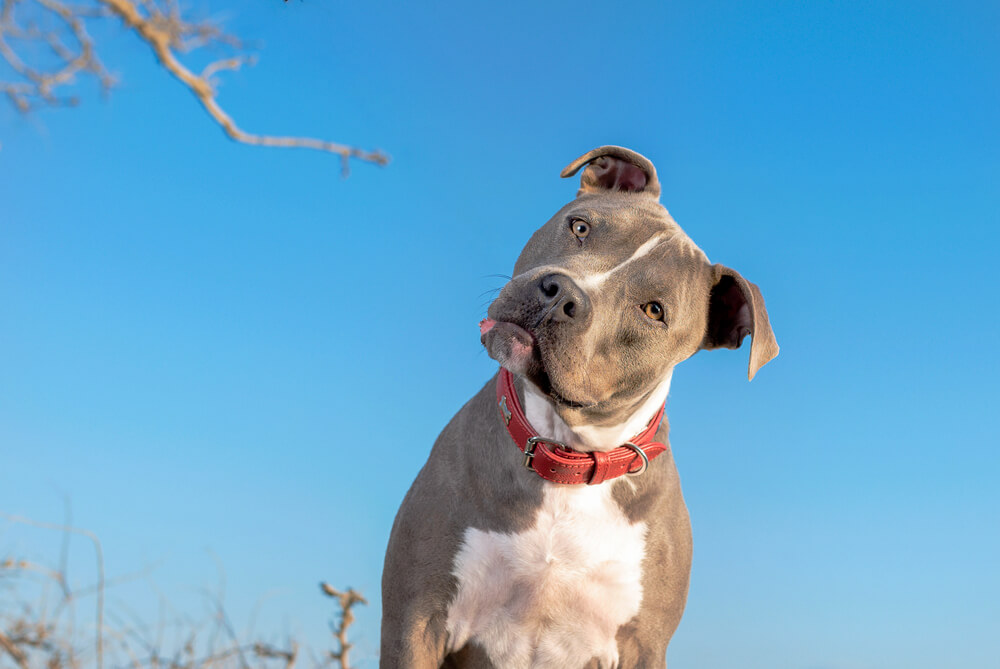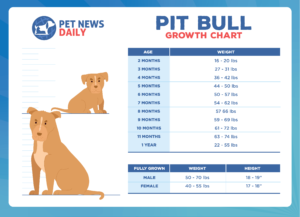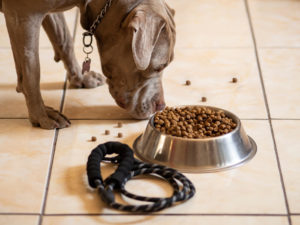We consulted with our veterinarian, Dr. Jennifer Coates, who reviewed and approved data about puppy weights and sizes, which we then used to create a convenient pit bull growth chart. You can use this as a reference to see how your puppy compares to the average.
The chart shows you a pit bull’s monthly average weight range during the growing phase. You can also refer to the puppy weight calculator to get an idea of how big your puppy is likely to get.
In This Article
Pit Bull Growth Chart
- 1 year: 25-55 pounds
- Fully grown males: 55-70 pounds, 18-19 inches
- Fully grown females: 40-55 pounds, 17-18 inches
Text Transcript of the Pit Bull Growth Chart
| Pitbull – Age | Weight | Height |
|---|---|---|
| 2 months 3 months 4 months 5 months 6 months 7 months 8 months 9 months 10 months 11 months 1 year |
16-20 pounds 27-31 pounds 36-42 pounds 44-50 pounds 50-57 pounds 54-62 pounds 57-66 pounds 59-69 pounds 61-72 pounds 63-74 pounds 25-55 pounds |
18-19 inches |
The American Pit Bull Terrier is one of the so-called bully breeds labeled a pit bull. In truth, “pit bull” isn’t a breed, but a term used to describe several other breeds, including the American Pit Bull Terrier, American Staffordshire Terrier, Bull Terrier, and Staffordshire Bull Terrier.
Many agree that the American Pit Bull Terrier and the American Staffordshire Terrier (AmStaffs for short) are the same, others say they’re different.
When looking specifically at AmStaffs, they are considered confident, courageous, and good-natured companions.1 Like most pit bulls, they have a stocky, muscular build, a well-defined jaw, pronounced cheekbones, a broad head, and round eyes set wide apart.
The breed descends from dogs raised in Great Britain that were created to excel in blood sports. According to the American Kennel Club (AKC), these dogs were expected to fight one another or attack other animals like bears and bulls as spectators watched. These harmful activities have since been outlawed, but they left behind a legacy of several breeds, including the Bulldog, Bull Terrior, and AmStaff.
The AKC decided in the 1930s to designate the breed as the American Staffordshire Terrier to separate it from its pit-fighting past. The group has not recognized the American Pit Bull Terrier.2 The United Kennel Club, however, has recognized it, and offers registration for the breed.3
If you recently brought home a pit bull puppy, you may be dealing with one or more of these breeds, depending on your puppy’s heritage. Regardless of the minor varieties in the breed, however, most will share general pit bull characteristics.
What Are the Growth Stages of a Pit bull?
Like most puppies, pit bull pups are born with their eyes and ears closed, which means they are blind and deaf for the first couple of weeks. They also have no teeth, and are completely reliant on their mothers for survival. Between one and three weeks of age, they will experience their most rapid growth. By three weeks, your pup’s eyes and ears will open and his teeth will emerge.
3 to 7 Weeks
During stage two, between three and seven weeks, your pup will interact with the other puppies in the litter as well as his human owners. He will continue to grow rapidly and will begin to learn social behaviors. By seven weeks, he should be running short distances, barking, wagging his tail, and in general, acting like a little dog.
7 to 12 Weeks
Between 7 and 12 weeks, your pup will be weaned from its mother and allowed to go to a new home. Training should begin at this time, and consists mostly of gentle play time, house training, and simple commands like “sit.”
12 to 16 Weeks
From 12 to 16 weeks, your puppy will become more independent and may act more like a toddler or teenager, refusing your commands and perhaps running away from you. This is when you can begin more serious obedience training so that she will learn appropriate behavior.
This is also when your pup will reach sexual maturity. Her adult coat will replace her puppy one, and when she will start teething, so keep your shoes safe! Talk to your veterinarian about the best time to spay and neuter your dog unless you are planning on having puppies.
16 to 40 Weeks
Between 16 to 40 weeks, your pit bull puppy will continue to grow and may go through periods of testing your authority. Stay consistent and use positive reinforcement for good behavior. Do not encourage mouthing or biting as this can lead to injuries later. It’s best to avoid games of tug-of-war at this time too as it can lead to dominance issues in some puppies.
40 Weeks and 1 Year
Between 40 weeks and one year, your dog will reach his mature size while still acting like a puppy. Daily exercise is important along with continued obedience training. Keep in mind that though your pup seems to be fully grown, she may continue to bulk out and may not reach her ultimate weight until the age of two or three years.
Feed Your Pit Bull Carefully
During all stages of your puppy’s growth, feed a high-quality medium- or large-breed food, depending on how big you expect your dog to get. (Large breeds are considered 50-60 pounds but less than 90 pounds. Smaller than that is a medium-sized breed.)4 These foods provide the proper nutrition for a big dog like a pit bull but slow the growth rate to decrease the risk of joint problems.
The best food for pit bulls will have high protein levels to sustain their muscle growth. Be careful not to overfeed. Pit bulls can gain too much weight pretty easily, particularly if you’re feeding a lot of treats or spending too much time cuddling on the couch.
Choose treats that are high in protein, not fat. Feed these only occasionally and refrain from giving your dog people food. Check your dog for ideal weight by examining her ribs. You should be able to feel them when you run your hand over your dog’s middle, but not see them when looking at your dog from the side. If you can’t feel them, your dog may be overweight.
You can also look at your dog from the top. She should have a bigger rib cage tapering to a defined waist. If your pit bull is one smooth line from chest to tail, she likely weighs too much. The World Small Animal Veterinary Association (WSAVA) offers some helpful illustrations of proper body condition.
How Big Do Pit Bulls Get?
If you’re curious as to how big your pit bull will get, there are a few ways to estimate her final size.
Begin with the puppy’s age. If she is under one year, she is still growing. Most pit bulls reach their full height at one year old, though they may still gain some weight after that.
Next, consider gender. As with many other animals, males are typically larger than females.5 Whereas females can weigh between 40-55 pounds, a male can weigh between 55-70 pounds.
Take a look at your puppy’s parents if you can. Genetics play a large role in determining what your dog will look like. Typically females will look like their mothers and males like their fathers.
You can also take a look at your puppy’s paws. If they seem oversized or out-of-proportion to the rest of the dog’s body, she is probably still growing and will eventually “grow into” her paw size.
Another way to estimate your puppy’s final weight is to use this simple formula:6
(Current weight/Age in weeks) x 52.
For example, if your pup is 25 pounds at 16 weeks of age, the formula would look like this:
(25/16) = 1.57 (rounded up)
1.57 x 52 = 82 (rounded up)
The best time to check your pit bull with this formula is when he reaches about 12-16 weeks of age. (The larger the dog, the longer you should wait.)
You can also use our puppy size predictor to find out how big your puppy might get as an adult. Or, if you want to see the growth rates of other dogs, we’ve also created a Golden Retriever size chart, Great Dane growth chart, Chihuahua size chart, and Labrador growth chart.
When Do Pit Bulls Stop Growing?
In general, your pit bull puppy will be fully grown at one year old. But though he will have reached his full height by then, he may continue to grow more muscular for the next year or two before reaching his ultimate adult size.
Things That Affect Pit Bull Growth
As long as you feed your pit bull a nutritious diet, give him regular exercise, and take him to the vet for regular checkups, he should have no problem growing into a healthy adult dog.
There are some things that can affect your puppy’s growth rate, however. Diet is a big one. Puppies need the right amount of nutrients to meet their developmental needs, so it’s important to be sure to use a high-quality food.
Pit bulls are more susceptible to certain health issues, including allergies, torn knee ligaments, thyroid problems, hip dysplasia, and cataracts. Allergies are common, and you may notice that your puppy has itchy skin. If you notice symptoms like excessive rubbing of the face and licking the paws, check with your veterinarian.
A dog that’s not reaching her proper weight may be struggling with worms in the intestines. Hookworms and tapeworms can affect all dogs, particularly if your dog ingests contaminated soil or feces containing worm eggs or larvae. Look for symptoms like diarrhea, vomiting, weight loss, bloated belly, and a dull, dry coat. Ask your veterinarian about deworming your pup.
Spaying or neutering your pit bull early in life may also affect his growth. It can delay the solidification of the puppy’s growth plates, leading to a taller, leaner, and less bulky dog. Check with your veterinarian to determine the best time to spay or neuter your dog.
Too much strenuous exercise (like running on pavement or fierce tugging) can also stress your dog’s bones and joints, so it’s important to maintain a gentle exercise routine until your dog is one year old.
Finally, over-feeding can affect growth. It may put extra weight and pressure on the developing joints, increasing the risk of joint problems later in life.
Pit Bull Weight Calculator
PUPPY WEIGHT CALCULATOR
Frequently Asked Questions
At six months, pit bulls can range from 15 to 35 pounds, depending on heritage and gender. Females will be on the smaller end of the scale, and males on the larger end.
It usually takes about a year for a pit bull to reach his full height, though he may continue to grow and develop more muscle after that. At six months, he will be about two-thirds of his final adult weight. Between two and six months, your puppy will experience his fastest growth rate.
To calculate your puppy’s adult weight, you can use a couple of different methods.
First, divide her weight at 20 weeks by her current age in weeks and multiply by 52. So if she weighed 35 pounds at 20 weeks, your equation would look like this:
35 divided by 20 = 1.75, 1.75×52=91 pounds.
It also helps to look at your puppy’s parents if you can, as he or she will likely resemble them in size. If you don’t know the breeder, check your puppy’s paw size. If it looks bigger than the rest of her body, she’s likely still growing and will eventually fill out so that the paws look more in proportion.
At four months, your male Pit Bull should be between 15-25 pounds, and your female between 10 and 20 pounds.
Pit Bulls can start developing signs of aggression between the ages of eight months and two years. You may notice signs before that, however, in some puppies, or you may notice a sudden aggression that you didn’t notice before. Some dogs may develop aggression when they reach sexual maturity at around six months of age.
Signs of aggression include barking and growling. More subtle signs include an alert gaze and a posture in which the dog seems to “rise up” on his toes. Proper obedience training is key for keeping any aggressive tendencies under control. Since the pit bull is typically very enthusiastic, it’s important to enforce proper manners early on.
As with most puppies, your pit bull will likely go through a period where she may seem hyperactive. This period typically lasts from three months to 12-18 months, after which you should notice your dog calming down. Consistent behavioral training is important during this entire time.
Additional Resources
If you’re looking for more information about dog growth in general, we’ve created a puppy weight calculator, an in-depth guide to how heavy your dog should be, and a series of growth charts for different breeds (and dogs and mixed breeds in general):
- Great Dane Growth Chart
- Goldendoodle Growth Chart
- Chihuahua Growth Chart
- Golden Retriever Growth Chart
- Labrador Growth Chart
- Dog Growth Chart
- Mixed Breed Growth Chart
- Rottweiler Growth Chart
- Pit Bull Growth Chart
- Australian Shepherd Growth Chart
- French Bulldog Growth Chart
- Great Pyrenees Growth Chart
- Standard Poodle Growth Chart
- Bernedoodle Growth Chart
- Husky Growth Chart
Article Sources
Pet News Daily uses only high-quality sources, including peer-reviewed studies, to support the facts within our articles. Read our editorial process to learn more about how we fact-check and keep our content accurate, reliable, and trustworthy.
- American Staffordshire terrier dog breed information. (n.d.). American Kennel Club. https://www.akc.org/dog-breeds/american-staffordshire-terrier/
- American pit bull terrier. (2011, January 19). DogTime. https://dogtime.com/dog-breeds/american-pit-bull-terrier
- American pit bull terrier. (n.d.). United Kennel Club (UKC). https://www.ukcdogs.com/american-pit-bull-terrier
- Pit bulls – Breeds & pictures. (n.d.). Pitbullinfo.org. https://www.pitbullinfo.org/pit-bulls-breeds-and-pictures.html
- Staff, A. (2017, May 11). Breed weight chart – American Kennel Club. American Kennel Club. https://www.akc.org/expert-advice/nutrition/breed-weight-chart/
- Puppy growth: What you need to know. (n.d.). Bond Vet. https://bondvet.com/b/puppy-growth



